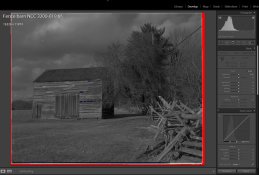Maris
Member
I wonder if there is actually any worthwhile subject matter out there with a viewable 19 stop luminance range. Can't recall ever encountering such.
I wonder if there is actually any worthwhile subject matter out there with a viewable 19 stop luminance range. Can't recall ever encountering such.
That’s me
But I’ve never encountered 19 stops.

Here's what I found with both my Epson V600 and V850. The full range of stops in the film is captured in one scan.What you are describing are operator errors/ lack of knowledge about what the scanner's bit depth & software are doing, not necessarily inherent scanner problems. Even your average CMOS camera sensor can largely (I'd say all current sensors, but there may be exceptions) pick up the entirety of the useful dynamic range in a BW negative in a single shot without problems - it's then up to the end user how to (hopefully intelligently) invert that & make tonal corrections. You should never, ever compromise a negative for scanning. Indeed, a lot of the nonsense about the supposedly 'huge' dynamic range from scans came from people realising they could scrape a bit more from stuff in the toe/ shoulder when using decently high end scanning solutions that were comfortably able to get every last bit of resolved latitude information (note: not 'all' information - there is a difference between resolved information contained on the film, and resolution of film structure information, and this is a problem that scanning seems to have never quite managed to understand, let alone tackle really convincingly) out of a film in a linear-ish fashion that might have needed complex darkroom masking procedures to otherwise retrieve.

This seems true if there is to be only a one to one transfer of values, but compression of tones to fit the reproduction media is standard.Even if there is a subject scene with so wide a dynamic range that it calls for capture medium that can support 19-stop range, ultimately one has to keep in mind that REPRODUCING that scene on paper or projected image is always inherently limited to the dyamic range of the reproduction media! and offset print images are limited to an even narrower range than conventional photosensitive printing papers.
So it ultimately is a rather moot issue that any B&W film can capture a high DR scene when the photosensitive paper cannot recreate the scene.
Hi, I am an experienced digital photog making an excursion into medium format analogue, and due to the cost of film and processing over here, am hoping to use the zone system to get myself shooting okayish photos pretty quickly and consistently.
Today I was given Kodak's 120 Tmax to try out, and when I Googled I found that the dynamic range is 19 stops!
How the heck do you use the zone system on that?
Does one:
or:
- Continue (generally) using three stops in either direction off middle grey (and assume the rest is just latitude for when you want to push the film, which I understand to mean shooting e.g. at 800iso even though it is 100iso)
Much appreciated!
- Do I need to convert the zone system for a 19 stop range, i.e. a zone now is the equivalent of just under two stops, and I now have a range of approx. 5 stops either side of middle grey?

What on earth gives you the impression you're going to get 19 usable stops out of it? I shoot both speeds of TMax all the time in multiple formats all the way from 35mm to 8x10, including a lot of 120 roll film. 12 stops of range is pushing your luck if you get sufficiently skilled metering for this film. Yes, there are a few specialty developers out there that squeeze down exposure extremes with any number of films into printable range, but are of the "compensating" variety which exacts a steep toll to midtone expansion and especially deep shadow differentiation. Some people, like the immediately preceding post, refer to that as "compression". I tend to think of it as stomping on a thick peanut butter sandwich to get it paper thin. In other words, it is a known tool of potential use in your tool kit, but certainly not a silver bullet. What I most dislike about traditional Zone System theory is that it relies too much on "minus development" or "compensation", or whatever you want to call it. But I still recommend learning the Zone System as a starting point.
But it is odd that neither speed of TMax is not being special order cut in ULF sizes, since after the demise of Super-XX and Bergger 200, it's one of the longest scale films still being made, and therefore would be especially appropriate for big contact prints (yet expensive!!!) I generally enlarge, but do sometimes contact print TMax negs.
What on earth gives you the impression you're going to get 19 usable stops out of it?...
I think that if you read my original post, that was the part I was struggling with, as I had no idea. The other answers since have helped me to understand the role/non-role of the extra stops, and how they do not factor into my zoning.
Exactly!TMX and TMY are available in ULF sizes through Keith Canham, but a purchaser has to be willing to wait for him to accumulate enough orders in any given emulsion/size to meet Kodak's minimum order requirements for a special cut.
https://canhamcameras.com/kodakfilm.html
what is it that doesn't work that way?Nope. It don't work that way.
| Photrio.com contains affiliate links to products. We may receive a commission for purchases made through these links. To read our full affiliate disclosure statement please click Here. |
PHOTRIO PARTNERS EQUALLY FUNDING OUR COMMUNITY:  |